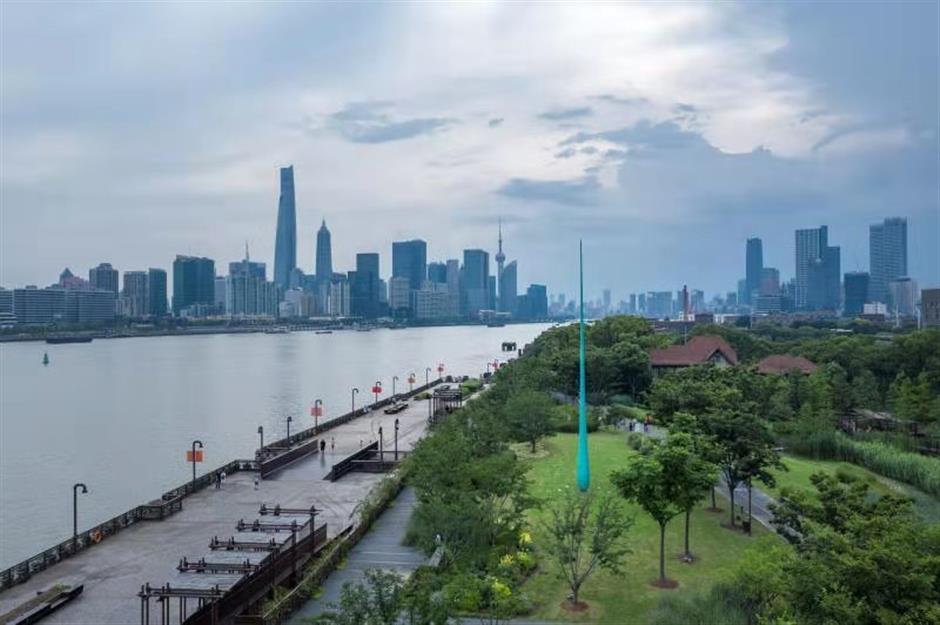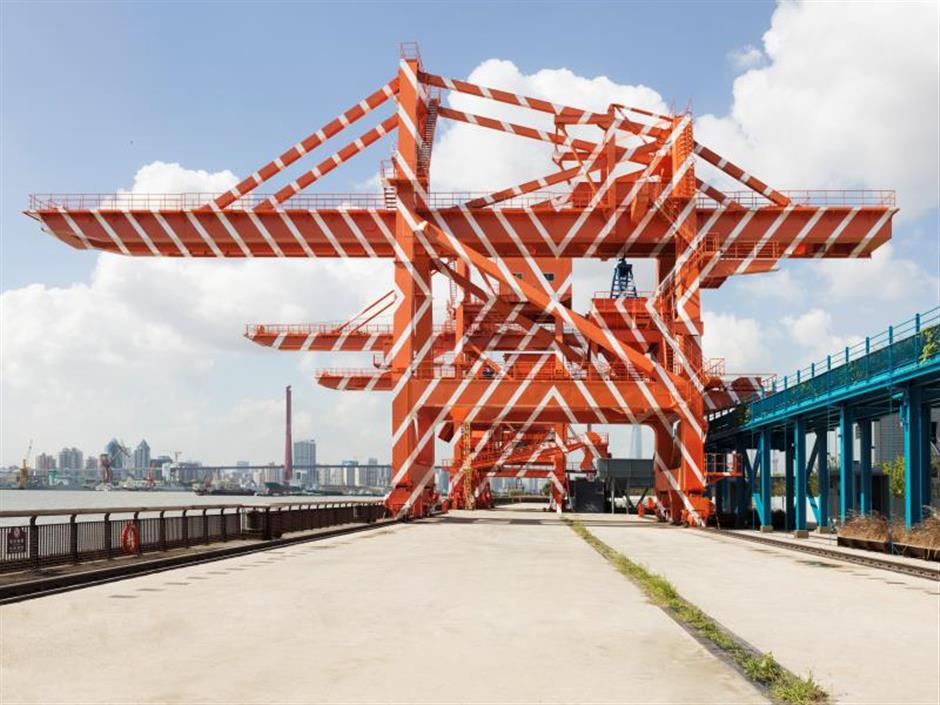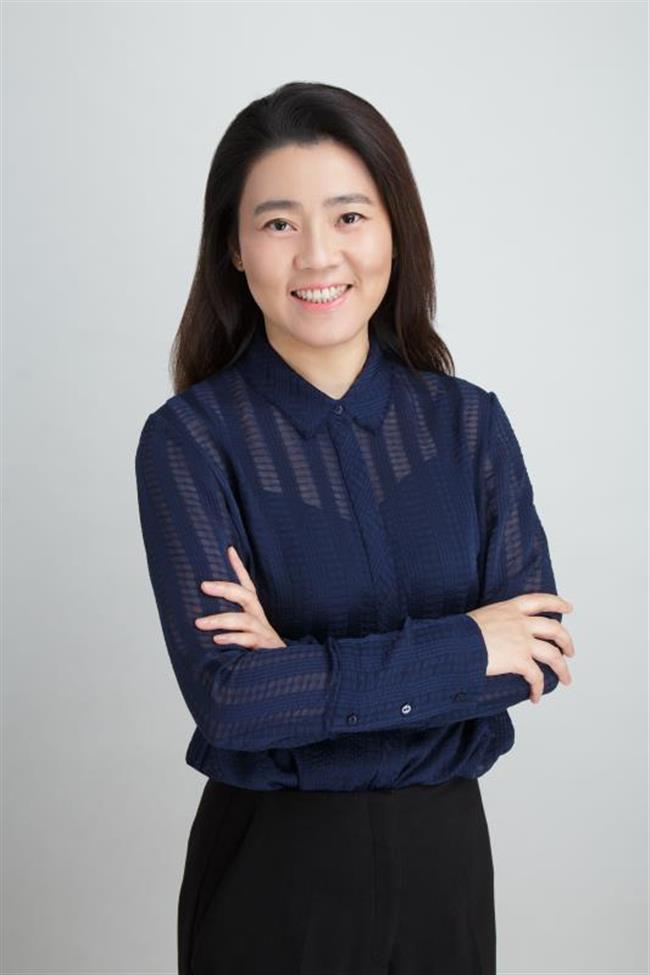Burgeoning art scene evolves from industrial wasteland

“Extraterrestrial Object” created by Liu Jianhua, one of China’s top contemporary artists
Once upon a time the Yangpu Riverside was home to various factories, warehouses and municipal infrastructure buildings. From east to west, factories stood tall and proud producing silk, wool, tobacco and soap, among many other things, as a signature of China’s industrial strength and cultural heritage.
But the 5.5-kilometer stretch, along the Huangpu River from Qinhuangdao Road to Liping Road, has been culturally reinvented and is now home to a burgeoning art scene.
The Yangpu Riverside has evolved, from all those old, abandoned buildings and dilapidated warehouses, into an indispensable art venue, booming with museums, galleries and art fairs.
“This is the biggest public art project financially supported by the government with a daunting figure of 150 million yuan,” said Art Pioneer Studio’s Robin Wong, the woman in charge of the project, from the initiation of the project, to the design, production, manufacture, implementation, consignment to the property management company and maintenance.
Twenty works of art, created by 29 artists from home and abroad, decorate the 5.5km riverside pedestrian avenue in Yangpu District. Big names such as Liu Jianhua, Xu Zhen, Song Dong, Oscar Oiwa and Felice Varini all contributed to the impressive project.
The works conjure up an immersive art experience for visitors, reflecting contemporary art, connecting history, memories and the urban reality of everyday life in Yangpu District.
Japanese artist Yusuke Asai’s “Wildness Growing up in the City” is perhaps the most interactive contribution to the project. Sited at Salvage Bureau Wharf, the work uses zebra-line white rubber materials to symbolize artifacts, making plant-symbolized flowers, and moving creature-symbolized birds to explore a natural way of existence in cities.
The artist invited nearby residents, teenagers and children to participate in his creations, and his work will be permanently retained in their living places. This piece of public art alters the top-down visual habit in a gallery and transforms viewers into the status of creators
The “Extraterrestrial Object” created by one of China’s top contemporary artists, Liu Jianhua, is simple and precise.
The outdoor sculpture takes the overwhelming shape of a falling raindrop; here the artist continues to explore the idea of “purity.” The abstract shape of the sculpture invites visitors to find connections between nature, life and art.
Coated in fluorescent paint, the 20-meter-long sculpture appears luminous against the night sky. The work-adopted colors were made of fluorescent materials. The luminous energy emitted by the material can be clearly seen, even at night. The artist also placed a laser light on top of the sculpture, radiating directly into the night sky. The long laser beam creates the “huge green raindrop,” which looks like an extraterrestrial object from outer space.
The “Set of Diagonals for Cranes” is an unmarked piece of art. This work takes shape on three disused orange unloading cranes located on the docks. The pattern, which can be only seen from one angle, sets up a dialogue between the three cranes, creating a work that communicates with the history of the site while situating it within a contemporary public art context.
“I use geometric composition to interact with reality. When you stand in the best observation point, you are replacing my eyes, but as you move and observe, you will obtain your own thoughts. Thus the so-called best observation point is very fragile, it is merely a beginning, a part of reality,” said Felice Varini, the artist who created a “Set of Diagonals for Cranes.”
The project also involves some indoor public art, such as “One Year/Ten Thousand Years” created by Yoshiyuki Kawazoe.
The site of the work is located in the Soapery Café, which was the old Shanghai Soap Factory. Inspired by a cave-like space and its historical use, Kawazoe has installed forms that resemble abstract stalagmites and stalactites made from plastic and coated in soap and salt. Each stalagmite and stalactite lights up at different intervals, engaging visitors’ olfactory sense and augmenting an immersive experience.
The most impressive venue in this project goes to “Gallery of ‘Mé’.” It is located in an underground space, which was originally used for the liquid storing of an electricity generator. When meandering through the downstairs, visitors will be bumped into a cavernous gallery installed with several works including two sculptures titled “Repetitive Object,” three circular acrylic sculptures titled “Acrylic Gas,” an LED installation “Lime” and a 9m-high seascape installation titled “Contact,” made of resin and wood.

“Set of Diagonals for Cranes" by Felice Varini
Tips for strolling the Yangpu Riverside:
Choose a sunny day, wear a pair of sneakers and do remember to inspect the labels on the ground from time to time so you don’t miss a real piece of public art.
It is advisable to enter the site at168 Gaoyang Road.

"One Year/Ten Thousand Years” created by Yoshiyuki Kawazoe
Trials and tribulations of overseeing 150m yuan art project
Robin Wong, the head of the curatorial execution team at Art Pioneer Studio Ltd, still vividly remembers every detail in implementing the government’s 150 million yuan art project along the Yangpu Riverside.
Wong, the founder of Art Pioneer Studio Ltd, director of APSMUSEUM and Vice President of Shanghai International Cultural Exchange Association, graduated from the Department of Architecture of Tongji University in Shanghai with a degree in Urban Planning.
With over 20 years experience in high-profile real estate development projects in international first-tier cities, she has a solid knowledge in architecture, construction and urban planning. Also an advocate in contemporary art, Robin said that she finally fused her passion of contemporary art into her career.
Fully occupied day and night with her team over the past several years, Wong said she found herself a bit of a “superwoman” because she went through an exhaustive communication process with bureau offices of the city and district, artists, design teams, manufacturing factories, among others.
“Patience, passion and persistence are the three key words to support me and my team to make this mission possible,” she said.

Robin Wong
Q: Did you realize the challenges you would encounter prior to the 30-month project?
A: To be honest, we did not realize there would be so many challenges and difficulties at the beginning. I knew the scale of the project was unprecedented in the contemporary art world of China, and I was quite confident that we could accomplish it with the help of my previous experience and the team’s hardworking spirit. However, after the project started, it turned out to be more difficult than expected, especially when coordinating different aspects. Such a big project not only involves the bureau offices of the city and district, the eight design teams, but also engaging with dozens of artists and manufacturing factories. For the 20 art projects presented, we signed more than 90 contracts, involving a large number of cooperating parties.
Q: How does that feel after you have finished such a big project? The high and the low moments?
A: I can proudly say that we are the best team in the public art world in China. Our advantages came from the funder’s background and the team’s structure, and the previous experience we had.
The most exciting moment was when the project was initiated — when it was approved by the government. This was the most challenging part of the whole procedure. After we had the approval, everything afterward could be carried out step-by-step.
The most depressing moment was when I realized I had to improve my coordinating ability, that I could have done better when dealing with some of the relationships. I have been reflecting and correcting myself. I also realized many weaknesses that still need to be improved.
Q: Did you ever make a compromise during the implementation process?
A: We always have to make compromises with artists, unless the artist’s work violates regulations or the main party’s requirements. Compromise is an attitude and also a strategy. In the process of compromise, artists see our hard work and tolerance, and in turn they will understand us. No matter compromise or tolerance or understanding, these are all necessary and mutual.
For example, we encountered the problem in Felice Varini’s “Set of Diagonals of Cranes.” At that time, the work had been completed and entered the maintenance stage. The artist came to Shanghai and saw a “Camera” sign on the ground, indicating it is the best spot to take photos of his work. The artist was very upset, saying that he did not want the audience to find this spot at once, but hoped that they would discover this angle by themselves in the process. This sign was added by the government. Of course, they are kind and hope that everyone can perceive the work in the best way, but they did not communicate with us in advance. We wrote to them but did not get a response. Later, the artist came to Shanghai, guess what? He said that we could add 14 more identical signs on the ground, so that everyone does not know which is true and which is false.
Q: What kind of public art can be deemed as “excellent” in your opinion? Among the 20, which one impressed you the most?
A: First of all, public art must be related to the public. Making a work of art in a public space where the public can enter and exit can be called public art, but it does not necessarily have a physical form or carrier to be called public art.
The safety of public artwork comes first. If something is done well but dangerous, it can’t be the top one. At the same time, this artwork needs to have a certain degree of interactivity and entertainment; to be able to interact with people; and of course, it also needs to be artistic.
All works are extremely outstanding. But I have three personal favorites: Richard Wilson’s “Huangpu Hold,” Oscar Oiwa’s “Time Shipper” and “Gallery of Me” by three Japanese artists Haruka Kojin, Kenji Minamigawa and Hirofumi Masui.
Q: Do you have any problems in terms of the maintenance of these artworks?
A: In terms of maintenance, crowd control and safety are also main issues that need to be resolved. Each of our works has a property management manual handed over to the management company. Although they have relatively little experience in maintaining artworks, they are constantly trying and learning.
We will also give special talks to the property management team on how to maintain and protect these works. Whenever something goes wrong, we will tell them how to solve it.
Q: What is your next art project after this?
A: Our recent official announcement was about a project located in Shanghai’s Qiantan Center, Shinji Ohmaki’s Space-Liminal Figuration. It is grander than any of the artworks in SUSAS in terms of size and investment.















